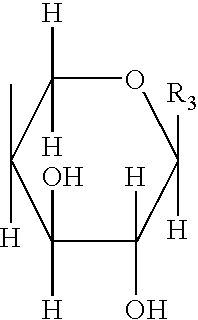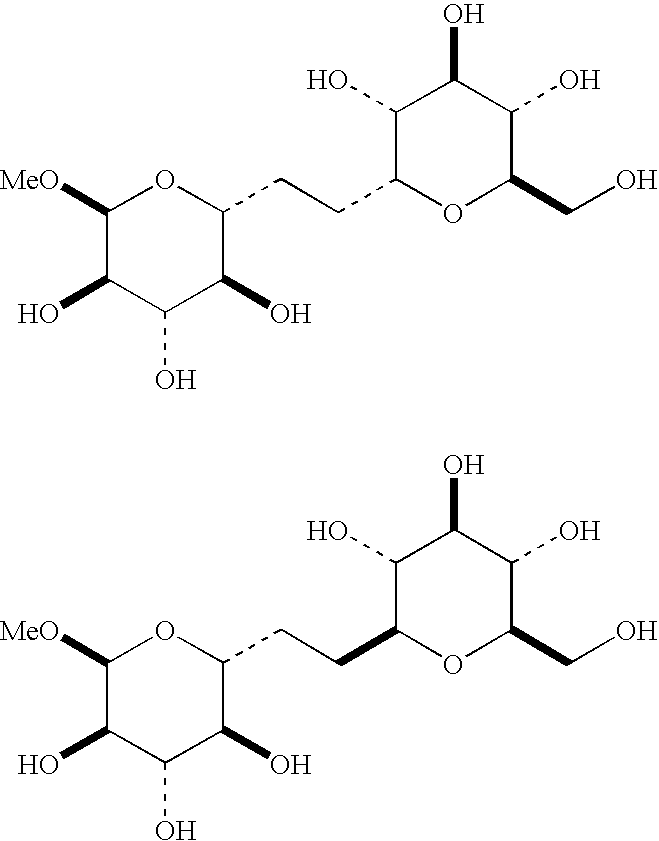C-glycoside compounds for stimulating the synthesis of glycosaminoglycans
a glycosaminoglycan and c-glycoside technology, applied in the direction of sugar derivatives, sugar compounds with non-saccharide radicals, biocide, etc., can solve the problems of reduced moisturization and tonicity of tissues, adverse effects of pgs and gags, and considerable disorganization, so as to improve the functionality of epidermal cells
- Summary
- Abstract
- Description
- Claims
- Application Information
AI Technical Summary
Benefits of technology
Problems solved by technology
Method used
Image
Examples
example 1
Example of a C-Glycoside Derivative of Xylose
[0558] Synthesis of C-β-D-xylopyranoside-n-propan-2-one of formula (i):
Procedure:
[0559] D-Xylose (1 g, 6.66 mmol) was dissolved in 10 ml of water in a 25 ml three-necked flask equipped with a condenser, a thermometer and a magnetic stirrer, followed by addition of 2,4-pentanedione (0.82 ml, 8 mmol) and sodium bicarbonate (839 mg, 10 mmol). The mixture was stirred for 6 hours at 90° C. The reaction medium was then washed with dichloromethane (twice 5 ml). The aqueous phase was passed through a Dowex 50X-200 resin which had been preconditioned with aqueous washes (the final solution was at pH 3-4). The eluate was concentrated and then co-evaporated with ethanol.
[0560] The light brown oil obtained was dried under vacuum (600 mg, i.e., a yield of 76%). 1H NMR: in accordance with the expected structure.
example 2
Example of C-Glycoside Derivatives of Fucose
[0561] With L-fucose as the starting material, this method provided a mixture of 2 isomers: [0562] 1-(C-β-L-fucopyranoside)propan-2-one, of formula (ii), and [0563] 1-(C-β-L-fucofuranosyl)propan-2-one, of formula (iii).
Procedure:
[0564] L-Fucose (0.913 g, 5.56 mmol) was dissolved in 10 ml of water in a 25 ml three-necked flask equipped with a condenser, a thermometer and a magnetic stirrer, followed by addition of 2,4-pentanedione (0.685 ml, 6.67 mmol) and sodium bicarbonate (0.70 g, 8.34 mmol). The mixture was stirred for 6 hours at 90° C. The reaction medium was then washed with dichloromethane (twice 15 ml). The aqueous phase was passed through a Dowex 50X-200 resin which had been preconditioned with aqueous washes (the final solution was at pH 3-4). The eluate was concentrated and then co-evaporated with ethanol.
[0565] The yellow oil obtained was dried under vacuum (674 mg, i.e. a yield of 59%). The oil was chromatographed on sili...
example 3
Example of Protection of a C-Glycoside Derivative of Xylose
[0566] Synthesis of C-β-D-(3,4,5-triacetoxy)xylopyranoside-n-propan-2-one of formula (iv)
[0567] 1-(3,4,5-Trihydroxytetrahydropyran-2-yl)propan-2-one (5.56 mmol) was dissolved in 10 ml of acetic anhydride in a three-necked flask, and a catalytic amount of ZnCl2 was added. The mixture was stirred overnight at room temperature. After stirring overnight, the mixture was diluted with ethyl acetate and the organic phase was washed with saturated NaHCO3 solution and then washed three times with water, dried over MgSO4, filtered and evaporated. The peracetylated sugar was obtained in quantitative yield.
PUM
| Property | Measurement | Unit |
|---|---|---|
| temperature | aaaaa | aaaaa |
| temperature | aaaaa | aaaaa |
| temperature | aaaaa | aaaaa |
Abstract
Description
Claims
Application Information
 Login to View More
Login to View More - R&D
- Intellectual Property
- Life Sciences
- Materials
- Tech Scout
- Unparalleled Data Quality
- Higher Quality Content
- 60% Fewer Hallucinations
Browse by: Latest US Patents, China's latest patents, Technical Efficacy Thesaurus, Application Domain, Technology Topic, Popular Technical Reports.
© 2025 PatSnap. All rights reserved.Legal|Privacy policy|Modern Slavery Act Transparency Statement|Sitemap|About US| Contact US: help@patsnap.com



